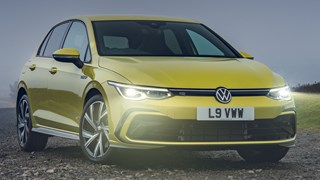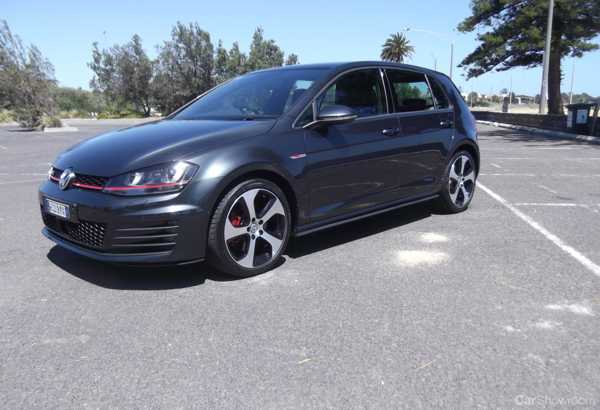The trophy case at Volkswagen’s Wolfsburg, Germany head office saw plenty of action last year. When a new generation Golf is launched, ‘Car Of The Year’ awards flow freely…but c’mon people do you think Volkswagen would ever muddle-up a new generation Golf?
Carshowroom.com.au has just handed-back the keys to a seventh generation Volkswagen Golf GTI and for sure the ‘King’ of mainstream performance hatchbacks remains ensconced at the top of the totem pole. But, like no previous generation, the Golf GTI is under threat from major players with excellent credentials.
We know how good the Volkswagen Golf GTI is because we’re owners. Well not now, but over the years we’ve owned three, including one of the original models from 1976 which we imported to Australia from England.
Volkswagen Golf GTI Overview
Apart from the pin-sharp new exterior and hallmark glamorous interior, the biggest news for the all-new seventh generation Golf is underneath – Volkswagen Group’s modular transverse matrix (MQB) platform. State-of-the-art, lightweight modern technology which is flexible across multiple vehicle types – trust Volkswagen to nail it.
So this model Golf is around 40kgs lighter than its predecessor.
Our Volkswagen Golf GTI was fitted with the six-speed dual clutch gearbox (DSG) automatic – standard is a six-speed manual with the hallmark golf ball lever.
Volkswagen Golf GTI Engine
Weight parings isn’t restricted to the body and chassis. As part of the improvements to the 2.0-litre turbocharged four-cylinder engine, Volkswagen has pared 7.8kgs – very impressive.
There’s also a new cylinder head and auto start/stop for improved fuel consumption – claimed to be up to 19 per-cent better.
Maximum power is now 162kW between 4500rpm-6200rpm (that’s up by 7.0kW) and peak torque of 350Nm is delivered between 1500rpm-4400rpm (that’s up by 70Nm).
Volkswagen Golf GTI The Interior
A tragedy – our Volkswagen Golf GTI test car was fitted with ‘Vienna’ leather seats in black rather than the hallmark check trim (a new design called ‘Clark’ in this seventh generation range). Thankfully some other cues to previous generations, like the ones we’ve owned, are there – the red lighting and alloy pedals.
Despite those one-colour seats, the latest Volkswagen Golf GTI really does further the tradition. The hallmark Volkswagen instruments, modern leather-wrapped three-spoke steering wheel and the excellent ergonomics.
Plus some newbies – for example the 5.8-inch infotainment touch-screen centre console is a first for Volkswagen.
But the big change for us is the extra space courtesy of Volkswagen’s new MQB flexible chassis architecture - the cabin 14mm longer overall and larger in every other dimension including shoulder width and leg-room. That’s apparent in the drivers’ seat and also in the rear.
And that extra space also pays dividends in cargo space – a very handy 1380-litres (that’s 30-litres more than the previous generation).
Volkswagen Golf GTI Exterior & Styling
Volkswagen is way too smart to depart from the Golf GTI styling traditions which are a major part of its sporty DNA. But the seventh-generation model does have one Golf GTI first – GTI badges (traditional type style of course) front and rear.
So on the basis that the seventh-generation model is the best-looking Golf so far, it stands to reason the GTI is the best looking GTI so far. We think so.
As we know, the seventh generation Volkswagen Golf has grown – the wheelbase up by 46mm to 2620mm and the overall length by 150mm to 4349mm. The other major styling shift has been the A-pillars which moved rearwards in this generation for a longer bonnet/cab rear look.
But the classic ‘Golf’ look and proportions (for example those often-copied C-pillars) are all there…in updated form.
Same for the GTI – the expected red strip around the grille and honeycomb air intakes. And of course the sporty Golf sits lower with a ride height reduced by 15mm and those massive (for this car) 18-inch alloy wheels.
At the front are unique LED fog-lights and black front splitter and at the rear there’s a rear diffuser (black again) and a larger roof spoiler which significantly extends the roof line in profile.
Volkswagen Golf GTI On The Road
A feature of recent generation Volkswagen Golf GTIs (and Audi A3 models sharing the same engine) has been the racy/sophisticated exhaust note of the turbocharged 2.0-litre engine – a note which was highlighted by the crackle and pops as the DSG auto snapped through the gears. Very DTM (German Touring Car Championship).
In fact some have criticized the exhaust note of the re-done 2.0-litre engine because it is a smidge flatter. A bit harsh that we reckon – it’s still an audio track worth turning-off the sound system for.
Some of our colleagues have also suggested the seventh generation Volkswagen Golf GTI doesn’t really need the extra cost of the adaptive dampers and 18-inch wheels for the seventh generation model. But this is the Golf GTI – and Volkswagen will always seek to push the technology boundary for its biggest-selling nameplate.
For us, this is a Volkswagen Golf just like its predecessors – planted, flat and phenomenally fast when pushed.
Differences? That electromechanical power steering is a definite step-up over Gen Six, the lighter weight and extra grunt are noticeable and we really liked the dynamics in the full-on Sport mode (steering, throttle and gear-change response) – a more appealing calibration for enthusiast drivers.
And just like its predecessor, in that mode, this Golf GTI was a delight over our high-speed mountain roads test loop – rushing into corners, braking with the DSG’s rapid-fire downshifts, turning-in with a precision some front-drive cars can only dream of and brilliantly balanced mid-turn via throttle adjustments with the electronic differential and ESC doing the job to maximize performance.
Back in the city, check-in your ego and switch from the ‘Sport’ setting to one of the more user-friendly driving dynamics choices. As usual, this is the trick of the Volkswagen Golf GTI – just like previous generations, this is a sporty hatchback which you’ll enjoy with equal proportion at track days and in the daily commuter grind.
Volkswagen Golf GTI Challenges
The original Mk 1 Volkswagen Golf GTI was conceived as a hot hatch every German could afford. At $41,490 – admittedly loaded with technology and equipment – the Mk 7 version is the premium-priced model in this ultra-competitive segment. For an outlay of $38,290 you get a lot of hot hatch with the Ford Focus ST (also a product of the German industry).
Volkswagen Golf GTI Verdict
‘Sport’ suspension setting is bordering on too firm even for enthusiasts like us – especially on poor secondary roads. Strange because we’ve spent countless hours on the secondary roads around Volkswagen’s head office in Wolfsburg, Germany and they’re…well, just as ‘secondary’ as here in Oz.
And we wouldn’t mind a bit less tyre noise on coarse chip bitumen.
Volkswagen Golf GTI The Competition
Have no doubt - for ride and handling, the all-new Mazda3 is right up there with the Volkswagen Golf (these two are the front of the pack in that department). Mazda3 doesn’t have an out-and-out performance model to match the GTI, but with 138kW/250Nm on-tap from Mazda’s excellent 2.5-litre Skyactiv-G petrol engine, there’s a lot to like in both the SP25 GT ($32,590 for the automatic) and SP25 Astina ($38,190 in automatic).
The German-origin Ford Focus is a definite Car Showroom favourite which is only very marginally behind the Volkswagen and Mazda duo in the twisty stuff. Here’s how good the racy 2.0-litre Focus ST ($38,290) is: a couple of our motoring journalist colleagues have parted with the own coin and purchased.
Although only available in the three-door body, Renault’s Megane RS265 ($42,640 - $51,640) is a blast. For ‘in-you-face’ looks, the Megane 265 gets the vote, especially with some of Renault’s wild paint colours. And of course unlike Volkswagen or Ford, there’s that current F1 connection with Renault.
























